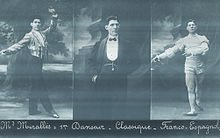Generalitat is the name of two major medieval and early modern political institutions and their modern-day analogues in Kingdom of Spain. The ancient Principality of Catalonia and the Kingdom of Valencia were ruled by Generalitats. Today, Catalonia and The Valencian Community have systems of self-government called Generalitats, and are two of 17 autonomous communities of Spain. The term is also used for the government of the semi-autonomous comarca of Val d'Aran, the Generalitat a l'Aran.

Valencian or Valencian language is the official, historical and traditional name used in the Valencian Community of Spain, and unofficially in the El Carche comarca in Murcia, to refer to the Romance language also known as Catalan. The Valencian Community's 1982 Statute of Autonomy and the Spanish Constitution officially recognise Valencian as the regional language.
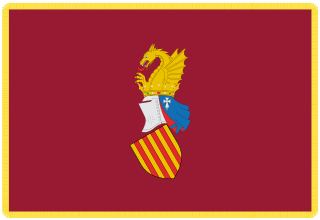
The Generalitat Valenciana is the generic name covering the different self-government institutions under which the Spanish autonomous community of Valencia is politically organized.

Valencian Union was a regionalist political party in the Valencian Community, Spain.

Xert is a municipality in the comarca of Baix Maestrat in the Valencian Community, Spain.
Benissanó is a municipality in the comarca of Camp de Túria in the Valencian Community, Spain.

Simat de la Valldigna is a municipality in the comarca of Safor in the Valencian Community, Spain. It is 50 km from Valencia, and 20 km from Cullera and Gandia. It is also near Xàtiva and Alzira.
Blaverism is a Valencian regionalist ideology in the Valencian Community (Spain) that emerged with the Spanish transition to democracy characterised by strong anti-Catalanism, born out of its opposition to Joan Fuster's book Nosaltres, els valencians (1962), which promoted the concept of the Catalan Countries which includes Valencia. They consider Fuster's ideas as an imperialist Catalan nationalist movement that tries to impose Catalan domination upon Valencia.

The flag of the Valencian Community and of the city of Valencia, known as Reial Senyera, is the traditional Senyera, composed of four red bars on a yellow background, crowned with a blue strip party per pale next to the hoist. It was adopted on 1 July 1982.
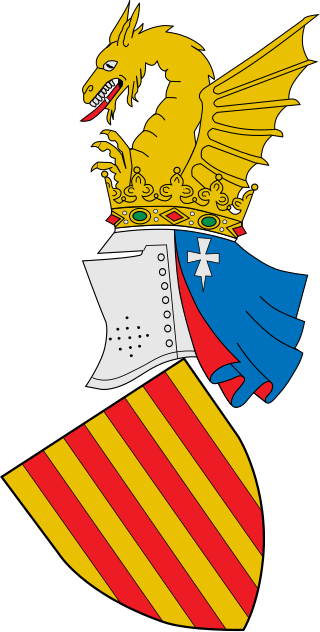
The coat of arms of the Valencian Community is the official emblem of the self-government institutions of the Valencian Community. It is based on the armorial achievement used from the reign of King Peter IV to John II, called the Great. In 1978 the former Council of the Valencian Country approved it “...for being the oldest known representative emblem of the former Kingdom of Valencia, that had located on the Xerea Gate of the city of Valencia”.
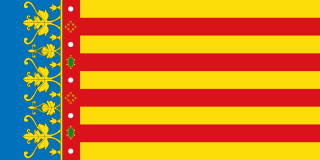
The Valencian Community is an autonomous community of Spain. It is the fourth most populous Spanish autonomous community after Andalusia, Catalonia and the Community of Madrid with more than five million inhabitants. Its homonymous capital Valencia is the third largest city and metropolitan area in Spain. It is located along the Mediterranean coast on the east side of the Iberian Peninsula. It borders Catalonia to the north, Aragon and Castilla–La Mancha to the west, and Murcia to the south, and the Balearic Islands are to its east. The Valencian Community is made up of three provinces: Castelló, Valencia and Alicante.
Capella de Ministrers is an early music group formed in 1987 in Valencia, Spain by Carles Magraner. Valencian music is prominent in its repertoire.
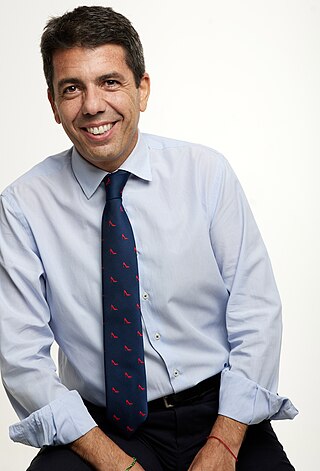
The president of the Valencian Government is the head of the Generalitat Valenciana, the government of the Spanish autonomous community of Valencia. The president is chosen by the Valencian parliament, the Corts Valencianes.

The Battle of Valencia was an identity conflict held in the Valencian society during the Spanish transition to democracy. It involved the progressive valencianism known as Fusterianism and the conservative anticatalanist regionalism known as blaverism.
Josep Palomero i Almela is a Valencian linguist and vice-president of the Valencian Language Academy.
Valencian Media Corporation, also known by its acronyms CVMC or VMC, is an agency of the Generalitat Valenciana, although with management autonomy and functional independence, in charge of producing and disseminating audiovisual products. Since 20 July 2016 is the successor of Radiotelevisió Valenciana, which was closed in 2013 by the ex-president Alberto Fabra by considering unaffordable the cost of staff readmission after justice considered illegal the layoff.

Dolores Johnson Sastre, also known as Lola Johnson, is a Spanish politician and journalist. She has been a councilor of the Generalitat Valenciana for the People's Party (PP) in the governments of presidents Francisco Camps and Alberto Fabra.

Valencian Art Nouveau, is the historiographic denomination given to an art and literature movement associated with the Art Nouveau in the Valencian Community, in Spain.

The first government of Ximo Puig was formed on 30 June 2015, following the latter's election as President of the Valencian Government by the Corts Valencianes on 25 June and his swearing-in on 28 June, as a result of the Socialist Party of the Valencian Country (PSPV–PSOE) and Commitment Coalition (Compromís) being able to muster a majority of seats in the Parliament with external support from We Can (Podemos) following the 2015 Valencian regional election. It succeeded the Fabra government and was the Valencian Government from 30 June 2015 to 17 June 2019, a total of 1,448 days, or 3 years, 11 months and 18 days.
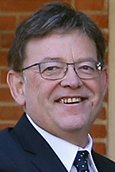
The second government of Ximo Puig was formed on 17 June 2019, following the latter's election as President of the Valencian Government by the Corts Valencianes on 13 June and his swearing-in on 15 June, as a result of the Socialist Party of the Valencian Country (PSPV–PSOE) emerging as the largest parliamentary force at the 2019 regional election. It succeeded the first Puig government and is the incumbent Valencian Government since 17 June 2019, a total of 1,508 days, or 4 years, 1 month and 17 days.
